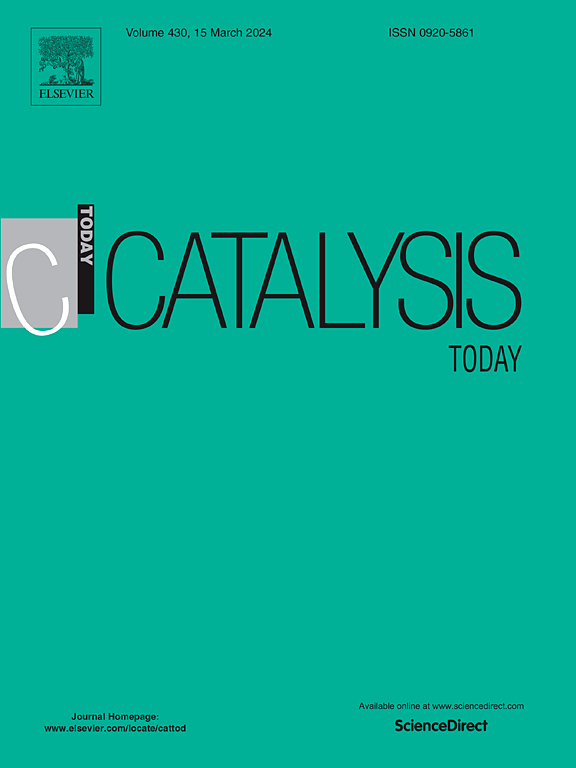薄荷叶合成TiO2颗粒的光催化和抗菌活性
IF 5.3
2区 化学
Q1 CHEMISTRY, APPLIED
引用次数: 0
摘要
以薄荷叶水提物和异丙醇钛溶液为原料,采用植物辅助合成法制备了锐钛矿TiO2纳米颗粒。对植物提取物改性钛溶液在两种不同温度下进行水热活化,并在400 °C下进行热处理。采用粉末x射线衍射分析(PXRD)、傅里叶变换红外光谱(FT-IR)、扫描电子显微镜(SEM)、能量色散x射线分析(EDS)、透射电子显微镜(TEM)、x射线光电子能谱(XPS)、漫反射光谱(DRS)、电子顺磁共振(EPR)和BET分析对制备的粉末进行了表征。结果表明,植物辅助样品比对照粉具有更高的比面积和更好的分散性能。TEM分析表明,在较高热液温度下获得的样品具有8-12 nm范围内的最小颗粒尺寸。随着HT和活化时间的增加,羟基的数量增加,晶格氧的数量减少。在合成过程中,植物提取物的加入改变了样品的结构和结构特征,导致M0(3.22 eV)和M0- h粉末(3.25 eV)的带隙值增大。上述物理化学特性使染料具有较好的吸附性能和内表面光照,从而提高了植物辅助合成颗粒对活性黑5染料uv引发变色的光催化活性(96% %)。所得光催化剂在连续三次循环中表现出较高的稳定性。实验证实了紫外线和粒子对大肠杆菌、铜绿假单胞菌、枯草芽孢杆菌和贫代谢芽孢杆菌的协同作用。与对照TiO2相比,植物辅助合成的粉末具有更强的抑制作用。本文章由计算机程序翻译,如有差异,请以英文原文为准。
Photocatalytic and antimicrobial activity of TiO2 particles, obtained by Mentha spicata leaves–mediated synthesis
The TiO2 anatase nanoparticles were obtained by plant-assisted synthesis using Mentha spicata (MS) leaves water extract and titanium isopropoxide solution. The hydrothermal activation of plant extract-modified titanium solution was carried out at two different temperatures and treated thermally at 400 °C. The prepared powders were characterized by the following techniques: powder X-ray diffraction analysis (PXRD), Fourier transform infrared (FT-IR) spectroscopy, Scanning Electron microscopy (SEM), Energy dispersive X-ray analysis (EDS), Transmission Electron microscopy (TEM), X-ray photoelectron spectroscopy (XPS), Diffuse reflectance spectroscopy (DRS), Electron paramagnetic resonance (EPR) and BET analyses. It was established that the plant-assisted samples possess higher specific area and better dispersion than those of the reference powders. The samples obtained at higher hydrothermal temperature (HT) possess the smallest particles sizes in the range 8–12 nm, according to TEM analyses. When both the HT and activation time increase, the amount of hydroxyl groups increases, while the amount of lattice oxygen decreases. The addition of plant extract during the synthesis process leads to changes of the textural and structural features of the obtained samples, which result in increasing of the band gap values for the M0 (3.22 eV) and M0-H powders (3.25 eV). All above mentioned physicochemical features cause better adsorption of the dye and inner surface illumination, thus resulting in improved photocatalytic activity of the plant-assisted synthesized particles towards Reactive Black 5 dye UV-initiated discoloration (96 %). The obtained photocatalysts exhibit high stability during three consecutive cycles. The synergistic effect of UV-light and particles on E. coli, P. aeruginosa, B. subtilis and O. paurometabola bacterial strains was demonstrated. The plant-assisted synthesized powders showed a stronger inhibitory effect compared to that of the reference TiO2.
求助全文
通过发布文献求助,成功后即可免费获取论文全文。
去求助
来源期刊

Catalysis Today
化学-工程:化工
CiteScore
11.50
自引率
3.80%
发文量
573
审稿时长
2.9 months
期刊介绍:
Catalysis Today focuses on the rapid publication of original invited papers devoted to currently important topics in catalysis and related subjects. The journal only publishes special issues (Proposing a Catalysis Today Special Issue), each of which is supervised by Guest Editors who recruit individual papers and oversee the peer review process. Catalysis Today offers researchers in the field of catalysis in-depth overviews of topical issues.
Both fundamental and applied aspects of catalysis are covered. Subjects such as catalysis of immobilized organometallic and biocatalytic systems are welcome. Subjects related to catalysis such as experimental techniques, adsorption, process technology, synthesis, in situ characterization, computational, theoretical modeling, imaging and others are included if there is a clear relationship to catalysis.
 求助内容:
求助内容: 应助结果提醒方式:
应助结果提醒方式:


